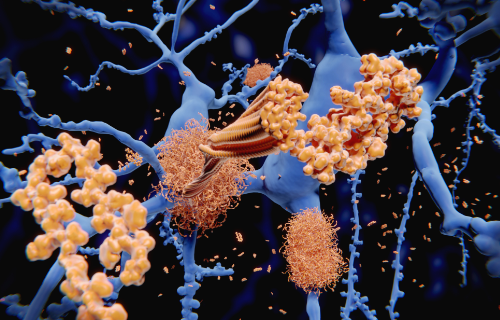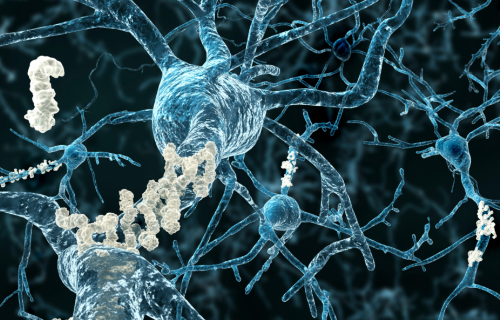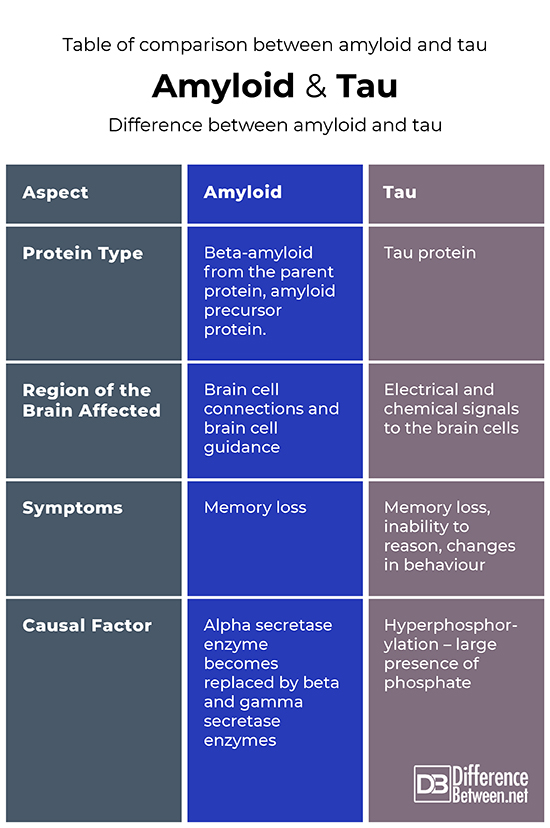Difference Between Amyloid and Tau

Beta amyloid (amyloid-β) and tau are both proteins synonymous with Alzheimer’s Disease. A clinical picture of an Alzheimer’s patient usually has to do with dead nerve cells and hardened plaques in between them. Within these plaques are proteins that occur in a twisted and tangled manner. In fact, it is these tangles that are responsible for the typical Alzheimer’s symptoms such as forgetfulness and behavioural issues.

Follow this article, as we delve deeper into the differences between beta amyloid and tau,
Definition
Beta Amyloids
Amyloid proteins are commonly known in the medical world for their contribution to Alzheimer’s disease. These proteins and found in the connecting pathways that trigger brain cells to pass chemical messages or electrical signals among each other. Interestingly enough, amyloids are not harmful until things go wrong.
Tau
Tau is a well-known protein that readily exists throughout the human body. In fact, they exist in each and every cell in the body. The exact function of tau proteins is to bind microtubules (important parts of cell structure) to keep them in a strong and supportive shape. Tau proteins are not harmful to the body, until an abnormality occurs.
Pathophysiology
Beta Amyloids
Beta amyloids are parented by amyloid precursor proteins, commonly known as APP.
A number of professionals say that the beta amyloid proteins allow brain cells to send signals. Other professionals are of the opinion that the beta amyloids are important in early development stages and guide cells on how to attach to each other. Despite the varying opinions, the fact remains that these proteins can become a serious problem once pathologies pop up.
The amyloids produced inside the brain are processed by the alpha secretase enzyme. This enzyme serves to dissect and remove any excess protein present. The problem comes in when this no longer happens. In patients with diseases such as Alzheimer’s, the enzymes doing the work are now beta and gamma secretase. These enzymes cut APP up into chunks of proteins, beta amyloids, which is not able to be metabolized by the brain.
Beta amyloids chunks become stuck to one another and end up as hardened deposited plaques in the brain cell connections. Once connection is cut off, the brain cells slowly start dying and cause quite significant memory loss.
Tau
Tau is better understood by scientists in comparison to the nature of beta amyloids and disease.
In cases such as Alzheimer’s Disease, tau proteins experience pathologies (or abnormalities). This process is referred to as hyperphosphorylation and, as the word suggests, involves phosphate molecules. Professionals have not yet managed to unravel the cause of this process.
When hyperphosphorylation occurs, an increased number of phosphate molecules appear. These phosphate molecules have a negative impact on tau proteins. Essentially, the molecules break the tau proteins down and cause them to lose their structural shape.
As a consequence of this, the tau proteins can no longer support microtubules in cells, and so they start to pull apart from them and clump together instead. Ultimately, this creates a messy tangle of tau proteins inside the pathways of the brain cells (neurons).
The messy tangle of tau proteins becomes bigger and bigger, and eventually the signals (both electrical and chemical) in the brain cells are blocked off from travelling to each other. You can imagine this as sand piling up in the middle of the road – it becomes more and more difficult to connect to the other side!
When neurons (brain cells) don’t receive signals, they eventually die off completely. If those brain cells that are blocked off happen to be in the memory area of the brain, then, as you can imagine, memory loss will slowly but surely begin. In other words, one will become more forgetful over time. If the blocked off brain cells are those in other areas such as the cerebral cortex, a person’s behaviour and ability to reason will be impaired.
Table of comparison between amyloid and tau

Summary
When processes involving amyloids (beta amyloid or APP) go rogue, brain cell connections and guidance are negatively impacted. More specifically, this tends to occur when alpha secretase enzyme becomes replaced by beta and gamma secretase enzymes. When processes involving tau proteins go rogue, electrical, and chemical signals battle to reach the brain cells. Particularly, when a large presence of phosphate suddenly occurs.
Both proteins (amyloid and tau) become stuck in clumps when their processes are disrupted. However, there are key differences in where that happens and what occurs. Amyloid disturbances cause memory loss and occur mostly in the hippocampus. Tau disturbances cause memory loss, changes in reasoning and altered behaviours, and generally occur in areas around the cerebral cortex.
Both proteins are associated with Alzheimer’s disease when they become altered. Although it must be highlighted that understanding the differences between the two is key to understanding how they cause disruption in the brain.
FAQ
What comes first tau or amyloid?
According to researchers, when beta amyloids start forming plaques in the brain there is a tendency for tau proteins to start accumulating and causing additional problems.
Does tau cause amyloid?
No. Just like amyloid, tau is a normal protein that occurs throughout the body. It is found in most cells.
How does amyloid affect tau?
Studies show that when beta amyloids start forming plaques, once formed from the amyloid precursor protein parent in the brain, there is a tendency for tau proteins to start accumulating and causing additional problems. Researchers do not yet understand how or why this happens.
What are amyloid plaques and tau tangles?
The amyloids produced inside the brain are processed by the alpha secretase enzyme. The problem comes in when this no longer happens. In patients with diseases such as Alzheimer’s, the enzymes doing the work are now beta and gamma secretase. These enzymes cut APP up into chunks of proteins, beta amyloids, which is not able to be metabolized by the brain. Beta amyloids chunks become stuck to one another and end up as hardened deposited plaques in the brain cell connections.
When hyperphosphorylation occurs, an increased number of phosphate molecules appear. These phosphate molecules have a negative impact on tau proteins. Essentially, the molecules break the tau proteins down and cause them to lose their structural shape. The tau proteins can no longer support microtubules in cells, and so they start to pull apart from them and clump together instead. Ultimately, this creates a messy tangle of tau proteins inside the pathways of the brain cells (neurons).
- Difference Between a Cochlear Implant and Normal Hearing - October 4, 2022
- Difference Between Obstructive and Restrictive Spirometry - September 11, 2022
- The Difference Between White Box and Black Box Testing - September 11, 2022
Search DifferenceBetween.net :
Leave a Response
References :
[0]Bloom, George. “Amyloid-β and Tau: The Trigger and Bullet in Alzheimer Disease Pathogenesis”. Clinical Implications of Basic Neuroscience Research, vol. 71, no. 4, 2014, pp: 505-508.
[1]Bushe, Marc.& Hyman, Bradley. “Synergy between amyloid-β and tau in Alzheimer’s disease”. Nature Neuroscience, vol 23, 2020, pp: 1183-1193.
[2]Jorgenson, Amber. “Beta-amyloid and Tau: What Do These Proteins Have to do With Alzheimer’s?” Discover Magazine, 2019. https://www.discovermagazine.com/mind/beta-amyloid-and-tau-what-do-these-proteins-have-to-do-with-alzheimers
